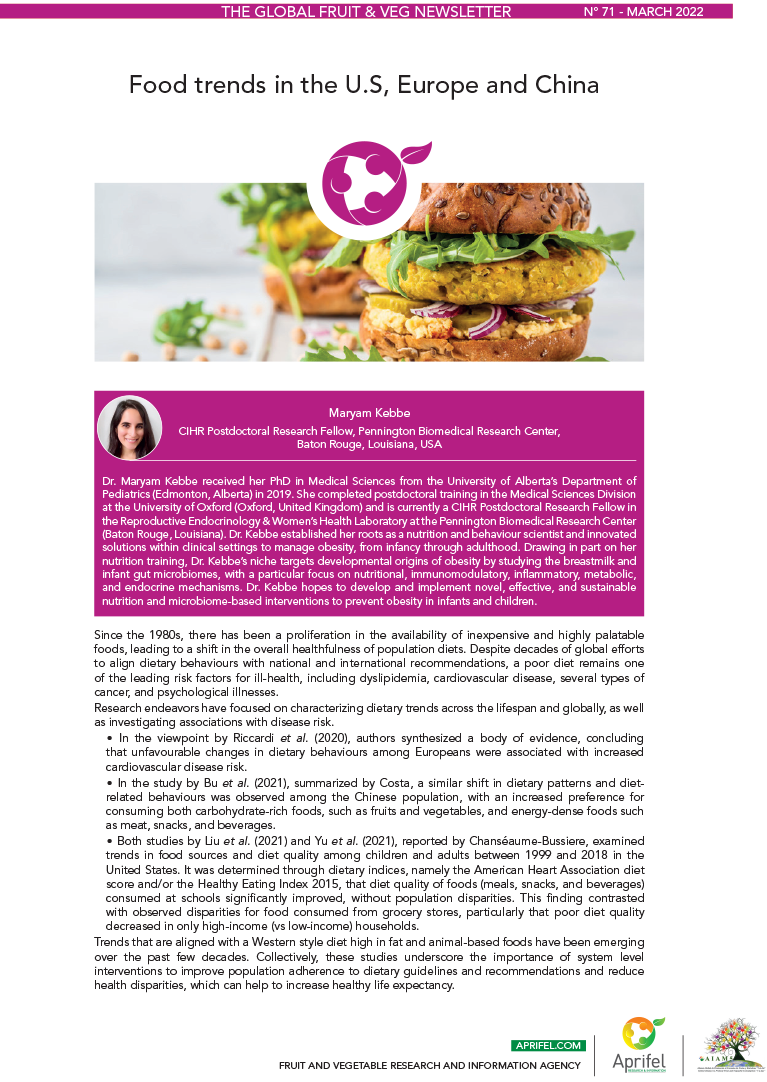China: New trends in terms of eating habits and consumption patterns

China’s economic and social development in recent years has had a considerable impact on the health and daily life of the Chinese population (Gonghuan, 2010; Broglia, 2011). In particular, its eating habits and consumption patterns experienced a major shift between 1997 and 2011, as shown in a six-wave health survey (Chinese Health and Nutrition Survey), with potential cardio-metabolic consequences (Popkin, 2006; Popkin 2012).
The present study aims to determine trends in diet-related behaviors and their interactions with cardio-metabolic diseases.
Improved living conditions
Between 1997 and 2011, several major changes occurred: the average age of the survey participants increased from 39 to 46 years, the urbanisation rate climbed by 11%, per capita income increased by 5298 yuan (€737), and the population achieved higher education levels, finishing primary school and moving on to middle school; on the other hand, there was an increase in sedentary behaviours.
Westernisation of diet …
Concerning eating habits, total food intake increased by 106 grams over the 15-year period and the successive survey waves found that the categories of foods consumed gradually became more diverse. Researchers reported significant increases in intakes of wheat (+9 g), vegetables (+13 g), fruit (+75 g), dairy products (+23 g), red meat and poultry (+24 g), fish, prawns and crab (+8 g), eggs (+9 g), snacks/fast food (+43 g), and beverages (+14 g). Intake levels surged for three categories in particular: dairy products (+1008%), snacks/fast food (+1787%) and beverages (+2959%). In parallel, intakes of traditional products such as rice and soya dropped sharply (by 91 g and 22 g respectively). In 2011, three food categories alone accounted for 65% of all foods consumed: vegetables (more than 32%), rice (23%), and wheat (10%).
… with excessive fat intakes
Over the 15-year monitoring period, there was a decrease in daily energy intakes (-363 kcal/day) in parallel with a sharp drop in the contribution of carbohydrates (-10%) and an increase in that of fat (+8.6%) and protein (+1.8%). In 2011, the contribution of fat to the energy intakes of the Chinese population (34%) exceeded the WHO recommendations (30%).
Changing consumption patterns
Between 1997 and 2011, the number of meals eaten per day in China increased from 2.93 to 3.47. In 2011, the Chinese population was more likely to eat a snack in the morning (+10% compared with 1997), afternoon (+19%) and late at night (+20%). Meals away from home (restaurants, workplaces) also increased over the years, whereas there was a slight decrease in meals eaten at home. Lastly, preparation methods changed: the participants eschewed traditional boiled preparations in favour of fried and stir-fried food.
Health concerns among top priorities despite an increase in the prevalence of overweight, obesity, hypertension and diabetes
Despite all this, the participants’ nutritional knowledge improved and a growing number of subjects said they tried to eat a balanced diet (+6%). Furthermore, they were more likely in 2011 than in 2004 to say they liked fruits and vegetables (+35% and +33%, respectively). However, the survey noted a rise in prevalence rates for overweight (+19%), obesity (+7%), hypertension (+10.8%) and diabetes (+3.4%) after the 15 years of monitoring.
The eating habits and related behaviours of the Chinese population have changed significantly over the past few decades while the prevalence of nutritional disorders has increased. Traditional diets rich in plants have gradually been replaced with a Western diet (refined cereals, meat, and ultra-processed products). While some changes (a more varied diet, choice of balanced foods) have been beneficial, others (increased consumption of snacks including late-night snacks, fast food, and sugar-sweetened beverages) could expose the population to a greater risk of developing metabolic and cardiovascular diseases.
Based on : Bu T et al. Trends in Dietary Patterns and Diet-related Behaviors in China. Am J Health Behav. 2021 Mar 1;45(2):371-383.
- Chinese eating habits and food consumption patterns have undergone a major shift over the past few decades.
- There has been a trend towards diversification and modernisation.
- Fruit intake has increased over the years. Although intakes of vegetables have only risen slightly, these nonetheless account for more than 30% of all foods consumed.

